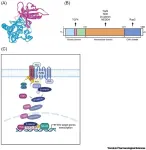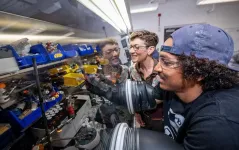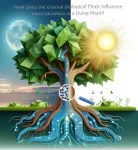(Press-News.org) May 28, 2024
Contact: Jim Erickson, 734-647-1842, ericksn@umich.edu
Graphic
Improved refrigeration could save nearly half of the 1.3 billion tons of food wasted each year globally
ANN ARBOR—About a third of the food produced globally each year goes to waste, while approximately 800 million people suffer from hunger, according to the U.N.'s Food and Agriculture Organization.
A new University of Michigan study concludes that nearly half of the food waste, about 620 million metric tons, could be eliminated by fully refrigerated food supply chains worldwide.
At the same time, fully refrigerated supply chains, or "cold chains," could cut food waste-related emissions of climate-warming greenhouse gases by 41% globally, according to the study published online May 28 in the peer-reviewed journal Environmental Research Letters.
Sub-Saharan Africa and South and Southeast Asia have the greatest potential for reductions in both food losses and related emissions through increased cold-chain implementation, according to the study.
South and Southeast Asia could see a 45% reduction in food losses and a 54% decrease in associated emissions under an optimized refrigeration scenario. Sub-Saharan Africa has tremendous opportunities for both food loss (47%) and emissions (66%) reductions under optimized refrigeration conditions, the study shows.
And in many situations, developing more localized, less industrialized "farm-to-table" food supply chains may yield food savings comparable to optimized cold chains, according to the study.
"I was surprised to find the scale of our opportunity for reducing food loss and waste globally," said study lead author Aaron Friedman-Heiman, a master's student at U-M's School for Environment and Sustainability and Ross School of Business. "Approximately half of the roughly 1.3 billion tons of food that goes to waste annually can be solved through food supply-chain optimization."
The other author is Shelie Miller, a professor at U-M's School for Environment and Sustainability and at the College of Engineering.
Food losses produce an estimated 8% of human-caused greenhouse gas emissions. The new U-M study focuses on food losses in the post-harvest to retail stages of the food supply chain and does not address on-farm or at-home losses.
The study accounts for the greenhouse gases emitted during food production. It does not include emissions tied to refrigeration or other supply-chain operations and does not include emissions from food waste in landfills.
The study, funded in part by Carrier Global Corp., found that:
The greatest opportunity to improve food losses in less industrialized economies is the supply chain between the farm and the consumer. But in North America, Europe and other more industrialized regions, most food loss happens at the household level, so cold chain improvements would not have a major impact on total food losses.
Reinforcing previous research, the U-M study highlights the importance of meat-related food losses. While the amount of fruit and vegetable losses is much higher, by weight, throughout the world, the climate-related emissions associated with meat losses are consistently greater than those associated with any other food type—due mainly to the high greenhouse gas intensity of meat production.
Unlike previous studies of this topic, the U-M researchers compared the benefits of globalized, technologically advanced food-supply chains with those of localized "farm-to-table" food systems. "Hyper-localized food systems resulted in lower food losses than optimized global, refrigerated supply chains," Friedman-Heiman said. "The results help quantify the value of maintaining and supporting local food chains."
For the study, the researchers built a food-loss estimation tool to assess how improved access to the cold chain could impact food loss and its associated greenhouse gas emissions for seven food types in seven regions. They used data from the U.N. Food and Agriculture Organization and other sources.
By modeling food losses at each stage of the supply chain, the study highlights where the cold chain can be optimized to reduce food losses and emissions. The researchers analyzed the effects of moving from the current state of inconsistent and variable-quality cold chains throughout the world to an optimized system, defined as one with high-quality refrigeration across all stages.
The study estimates that poor cold-chain infrastructure could be responsible for up to 620 million metric tons of global food loss annually, resulting in emissions of 1.8 billion tons of carbon dioxide equivalents, the equivalent of 28% of U.S. annual greenhouse gas emissions.
The researchers say their adaptable, easy-to-use tool will be of use to anyone involved in the food supply chain, including farmers, grocery retailers, government officials and nongovernmental organizations.
"Although cold chain infrastructure is rapidly increasing worldwide, an optimized cold chain will likely develop at different rates and in different ways across the globe," Miller said. "This analysis demonstrates that while increased refrigeration should lead to improvements in both food loss and greenhouse gas emissions associated with food loss, there are important tradeoffs associated with cold chain improvements by food type and region."
She said Investment decisions will need to be prioritized to maximize the desired outcomes and impacts. For example, if an NGO's top priority is ending hunger, then cold-chain upgrades that provide the greatest overall food-loss reductions may best meet that objective.
But organizations that prioritize climate action may choose to focus on reducing meat losses specifically, rather than total food losses.
The study found that meat accounts for more than 50% of food loss-related greenhouse gas emissions, despite accounting for less than 10% of global food losses by weight. Optimized refrigeration of meat could result in the elimination of more than 43% of emissions associated with meat loss, according to the study.
The researchers emphasize that the actual amount of greenhouse gas emissions savings will depend on the efficiency of cold-chain technologies and the carbon intensity of local electrical grids, since climate emissions associated with refrigeration can be significant.
The U-M study was supported by the U.S. National Science Foundation and by Carrier Global Corp., a global leader in intelligent climate and energy solutions.
Study: The impact of refrigeration on food losses and associated greenhouse gas emissions throughout the supply chain (DOI: 10.1088/1748-9326/ad4c7b)
END
Improved refrigeration could save nearly half of the 1.3 billion tons of food wasted each year globally
2024-05-28
ELSE PRESS RELEASES FROM THIS DATE:
From fibrosis and cancer to obesity, Alzheimer’s and aging: New paper reveals broad potential of TNIK as a therapeutic target
2024-05-28
A new paper in Trends in Pharmacological Sciences from researchers at generative artificial intelligence (AI)- and robotics-powered clinical stage drug discovery company Insilico Medicine (“Insilico”) and ETH Zurich reveals the broad potential of TNIK as a therapeutic target for some of the most pervasive aging-related diseases, including fibrosis, cancer, obesity, and Alzheimer’s. The findings could guide the development of new therapeutics. The lead drug in Insilico’s pipeline, INS018_055, is an AI-designed TNIK inhibitor being advanced as a treatment ...
Finnish Vole fever spreading further south
2024-05-28
Researchers have discovered that bank voles in southern Sweden (Skåne) carry a virus that can cause hemorrhagic fever in humans. This finding was made more than 500 km south of the previously known range. The virus strain discovered in Skåne appears to be more closely related to strains from Finland and Karelia than to the variants found in northern Sweden and Denmark. This is revealed in a new study from Uppsala University, conducted in collaboration with infectious diseases doctors in Kristianstad and published ...
Prenatal exposure to air pollution associated with increased mental health risks
2024-05-28
A baby’s exposure to air pollution while in the womb is associated with the development of certain mental health problems once the infant reaches adolescence, new research has found. The University of Bristol-led study, published in JAMA Network Open today [28 May], examined the long-term mental health impact of early-life exposure to air and noise pollution.
Growing evidence suggests air pollution, which comprises toxic gases and particulate matter, might contribute to the onset of mental health problems. It is thought that pollution could negatively affect mental health via numerous ...
New research supports expansion of kidney donation to include organs from deceased patients who once had dialysis
2024-05-28
Researchers from Johns Hopkins Medicine propose a novel approach to addressing the pressing issue of a kidney donor shortage through findings that suggest a promising method to expand the pool of available kidney donors by utilizing deceased donors on dialysis for kidney transplants.
The findings, published in the May 23rd issue of JAMA, identifies that while those who received such kidneys experienced a “significant delay” in the function of the transplanted organ compared to those ...
A cleaner way to produce ammonia
2024-05-28
– By Rachel Berkowitz
Ammonia is the starting point for the fertilizers that have secured the world’s food supply for the last century. It’s also a main component of cleaning products, and is even considered as a future carbon-free replacement for fossil fuels in vehicles. But synthesizing ammonia from molecular nitrogen is an energy-intensive industrial process, due to the high temperatures and pressures at which the standard reaction proceeds. Scientists from the Department of Energy's Lawrence Berkeley ...
How killifish embryos use suspended animation to survive over 8 months of drought
2024-05-28
The African turquoise killifish lives in ephemeral ponds in Zimbabwe and Mozambique. To survive the annual dry season, the fish’s embryos enter a state of extreme suspended animation or “diapause” for approximately 8 months. Now, researchers have uncovered the mechanisms that enabled the killifish to evolve this extreme survival state. They report May 30 in the journal Cell that although killifish evolved diapause less than 18 million years ago, they did so by co-opting ancient genes ...
Harnessing green energy from plants depends on their circadian rhythms
2024-05-28
WASHINGTON, May 28, 2024 —When plants draw water from their roots to nourish their stems and leaves, they produce an electric potential that could be harnessed as a renewable energy source. However, like all living things, plants are subject to a circadian rhythm — the biological clock that runs through day and night cycles and influences biological processes. In plants, this daily cycle includes capturing light energy for photosynthesis and absorbing water and nutrients from the soil during the day and slowing its growth processes at night.
In a study published this week in ...
Financial burden of health care in the privately insured US population
2024-05-28
About The Study: In this national cross-sectional study of privately insured U.S. families, inflation-adjusted health care spending increased from 2007 to 2019, largely owing to increasing contributions to premiums. Annual financial medical burden increased significantly, both overall and among low-income and higher-income families. Mean financial medical burden was more than 26% of postsubsistence income for low-income families, compared with approximately 6% for higher-income families.
Corresponding ...
Mortality risk among women with premenstrual disorders in Sweden
2024-05-28
About The Study: The findings of this matched cohort study suggest that women with premenstrual disorders are not at increased risk of early death overall. However, the risk was elevated among young women and for death by suicide. This supports the importance of careful follow-up for young patients and highlights the need to develop suicide prevention strategies for all women with premenstrual disorders.
Corresponding Author: To contact the corresponding author, Marion Opatowski, Ph.D., email marion.opatowski@ki.se.
To access the embargoed ...
Early vs late anticoagulation in minor, moderate, and major ischemic stroke with atrial fibrillation
2024-05-28
About The Study: The treatment effect of early direct oral anticoagulant initiation did not differ in people with minor, moderate, or major stroke assessed by brain imaging. Early treatment was not associated with a higher rate of adverse events, especially symptomatic intracranial hemorrhage, for any infarct size, including major stroke.
Corresponding Author: To contact the corresponding author, Urs Fischer, M.D., M.Sc., email urs.fischer@insel.ch.
To access the embargoed study: Visit our For The Media website at this link https://media.jamanetwork.com/
(doi:10.1001/jamaneurol.2024.1450)
Editor’s ...




